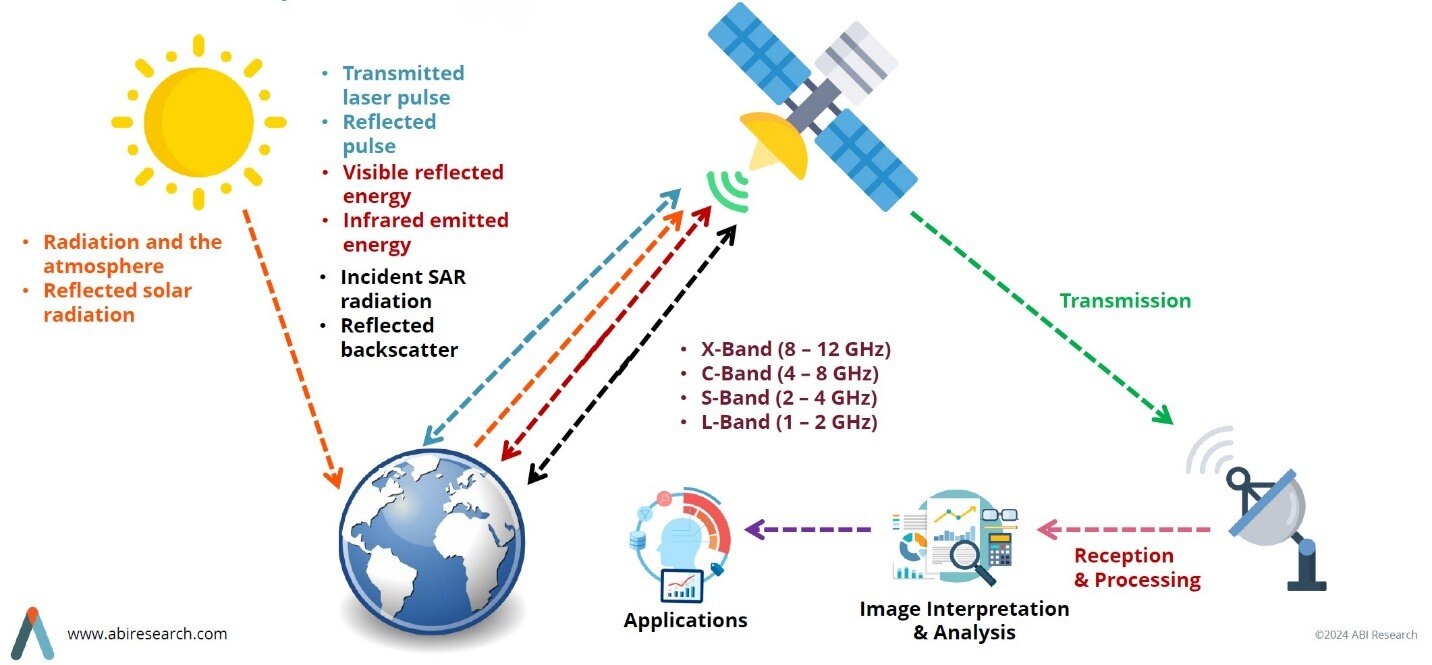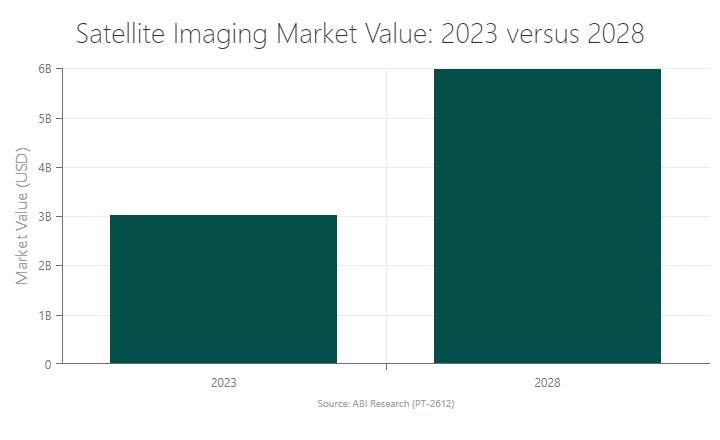Satellite imagery is rapidly emerging as an essential technology for industries requiring precise, continuous, and real-time monitoring solutions. It enables organizations to track everything from agricultural fields to military assets with unparalleled accuracy. As covered in ABI Research’s Satellite Imaging Platforms Developments & Outlook presentation, the technology is rapidly evolving and expanding its use cases across diverse industries.
As the need for precise geospatial data grows, satellite imagery has become an invaluable resource for businesses and governments globally. This article delves into key market trends and examines common applications of satellite imaging technology.
Figure 1: The Mechanics of Satellite Imaging

Types of Satellite Imagery
Table 1 provides a brief overview of the six distinct types of satellite imagery that can be utilized.
Table 1: Types of Satellite Imagery
(Source: ABI Research)
|
Satellite Imagery Type |
Description |
Common Applications |
|
Multispectral Imagery |
Captures data across multiple wavelengths, including beyond the visible spectrum. |
Environmental monitoring, vegetation analysis, land cover classification. |
|
Hyperspectral Imagery |
Collects numerous tiny and contiguous spectral bands, offering higher spectral resolution than multispectral imagery. |
Mineral detection, agricultural assessments, material identification. |
|
Panchromatic Imagery |
Captures a wide spectrum of light in one band, producing high-resolution black and white images. |
Infrastructure building, urban planning, comprehensive visual interpretation. |
|
Synthetic Aperture Radar (SAR) |
A remote sensing technique using microwave signals to produce high-resolution images that penetrate clouds and darkness. |
Topography mapping, subsidence monitoring, disaster response, military surveillance. |
|
Interferometric SAR (InSAR) |
Combines multiple SAR images to create interferograms, useful for detecting ground deformations. |
Tracking tectonic activity, monitoring landslides, earth subsidence, and infrastructure stability. |
|
Thermal Infrared Imagery |
Captures surface heat to show temperature variations across regions. |
Urban heat island monitoring, thermal anomaly research, energy efficiency evaluations, environmental monitoring. |
Satellite Imagery Trends
AI and Machine Learning in Satellite Data Analysis
Artificial Intelligence (AI) and Machine Learning (ML) are revolutionizing satellite imagery analysis by automating data processing and enhancing accuracy. These technologies accelerate pattern recognition, simplifying the interpretation of vast amounts of imagery data. AI and ML are widely applied in detecting land use changes, monitoring environmental events, and generating predictive analytics across multiple industries.
Miniaturization and Small Satellite Constellations
The rapid growth in the deployment of Small Satellites (SmallSats) is another key trend in the satellite imagery market. SmallSats, such as cubesats, picosatellites, and nanosatellites, are favored for their lower costs and ease of deployment. These satellites often operate in large constellations to provide continuous Earth observation.
In 2022, over 2,400 SmallSats were launched. This represents a 35% increase from 2021 and reflects the growing demand for real-time, continuous coverage of the Earth's surface. The SmallSat market is poised for further growth as their capabilities expand.
Geospatial Data Fusion
The fusion of data from multiple sensor types, such as optical, Synthetic Aperture Radar (SAR), and hyperspectral sensors, enhances the quality of satellite imagery. This combination provides a comprehensive view of the observed areas and enables more in-depth analyses. This technique is particularly valuable for complex studies, such as environmental monitoring, disaster response, and urban planning.
Enhanced Imaging Capabilities
Advancements in imaging technology have significantly improved the resolution and clarity of satellite images. High-resolution optical imaging and SAR technologies can now capture incredibly detailed images, even in poor weather conditions or at night.
Optical imaging has achieved Ground Sample Distances (GSDs) as low as 30 to 50 centimeters. Furthermore, modern SAR systems offer resolutions as fine as 0.5 meters per pixel, allowing for more precise applications like urban planning and military surveillance.
Common Satellite Imagery Applications
Environmental Monitoring
Satellite imagery is a vital tool in monitoring and protecting the environment. It enables governments, environmental organizations, and scientists to track ecosystem changes (e.g., flora and fauna tracking), monitor pollution levels, and observe natural disasters in real time. This allows for a proactive approach toward disaster response and biodiversity conservation.
Satellite images are also instrumental in monitoring deforestation and tracking climate change. For instance, by analyzing satellite images over time, scientists can detect the rate of forest loss and identify areas at risk of desertification. In this way, satellite imagery serves as an early warning system for global environmental crises.
Real-Life Example: Coastal Monitoring in Tamil Nadu, India
In Tamil Nadu, satellite imagery was used to identify flood-prone zones in the coastal region. These data helped local authorities improve disaster response plans and build resilience among coastal communities. By combining satellite data with remote sensing data and Geographic Information Systems (GIS), the project successfully produced accurate flood hazard maps. These maps are now being used to mitigate risks and protect vulnerable populations.
Military and Defense
In military and defense operations, satellite imagery provides critical intelligence for national security. Governments and defense agencies use satellite images to monitor troop movements, track military infrastructure, run reconnaissance, and support tactical decision-making. When satellite imaging analysis is combined with AI and ML techniques, defense stakeholders can detect and track specific vehicle types, aircraft, ships, and military hardware. This helps minimize collateral damage when striking a target.
Satellite imagery also plays a significant role in post-battle damage assessment. Defense agencies can evaluate the effectiveness of military operations and plan for subsequent actions by viewing the damage inflicted on enemy infrastructure and equipment.
Real-Life Example: Russia-Ukraine Conflict
During the ongoing Russia-Ukraine conflict, satellite imagery has been used extensively to track troop movements and military infrastructure changes. Sentinel-1 satellites provided real-time data, which proved vital for assessing potential threats and supporting defense operations. These high-resolution images detect changes in troop deployment and military assets, ensuring timely responses to possible threats.
Agriculture
Satellite imagery has become an essential tool in modern agriculture. It helps farmers optimize crop health, manage water usage, and improve yield predictions. By analyzing satellite-based data, farmers can make informed decisions that enhance their productivity. For instance, satellite images can support farmers’ irrigation management by identifying soil moisture variations. This will prompt an agricultural organization to optimize irrigation schedules.
In addition to crop monitoring, satellite imagery generates land cover classifications. This enables farmers to plan agricultural expansion and manage land resources more efficiently.
As per the United Nations Food and Agricultural Organization (FAO), farmers using satellite imagery for crop monitoring average a 12% increase in crop yield.
Real-Life Example: Apollo Agriculture in Kenya
Apollo Agriculture and Harvesting Inc. have integrated satellite imagery into their business models to monitor the health of crops across rural Kenya and assess the creditworthiness of loan applicants. The satellite data are used to:
- Predict farm crop yields
- View crop mapping
- Evaluate farm diversification
- Identify trends in production
Satellites also accurately identify the Global Positioning System (GPS) boundaries of farms, which is essential for field mapping purposes.
Satellite-based information has helped smallholder farmers access affordable credit and increase farm productivity. The collected data are processed using advanced algorithms and ML techniques to extract relevant information for credit scoring.
Finance & Insurance
Satellite imagery is increasingly being used in the financial and insurance sectors. It provides insights into economic activity, assists in supply chain risk assessment, and improves the accuracy of claims processing. Hedge funds, insurance companies, and banks use satellite images to gather data on consumer behavior, shipment containers, commodity production (crops, oil, metals, etc.), and infrastructure conditions.
Real-Life Example: Hedge Fund Insights from Retail Monitoring
UBS Investment Research used satellite imagery to monitor parking lot activity at major retail chains like Walmart. By analyzing satellite images of parking lots, UBS accurately predicted quarterly sales and adjusted its investment strategies accordingly. The use of high-resolution imagery gave UBS a competitive advantage over traditional data sources. The company can make more informed risk management and investment decisions than its competitors.
In the insurance sector, companies like ICEYE use SAR technology to monitor natural disasters like floods. These data are used to trigger parametric insurance policies, which provide immediate payouts based on predefined conditions. For instance, a flood insurance program in New York City leverages real-time satellite data to offer up to US$1.1 million in relief to low-income households affected by floods.
Conclusion
Satellite imagery solutions are rapidly evolving, with advancements in AI/ML driving their growth. From environmental monitoring to defense, agriculture, insurance, and finance, satellite imagery provides significant data-backed value across sectors.

As adoption continues to expand and case studies build up, more businesses will leverage satellite data for strategic decision-making and risk management. This will result in the satellite imaging market value nearly doubling between 2023 and 2028, reaching almost US$6 billion.
To explore the latest developments and future trends in the satellite imaging market, download ABI Research’s comprehensive report on satellite imaging platforms here.


